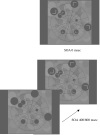Contextual cuing by global features
- PMID: 17355043
- PMCID: PMC2678916
- DOI: 10.3758/bf03193721
Contextual cuing by global features
Abstract
In visual search tasks, attention can be guided to a target item--appearing amidst distractors--on the basis of simple features (e.g., finding the red letter among green). Chun and Jiang's (1998) contextual cuing effect shows that reaction times (RTs) are also speeded if the spatial configuration of items in a scene is repeated over time. In the present studies, we ask whether global properties of the scene can speed search (e.g., if the display is mostly red, then the target is at location X). In Experiment 1A, the overall background color of the display predicted the target location, and the predictive color could appear 0, 400, or 800 msec in advance of the search array. Mean RTs were faster in predictive than in nonpredictive conditions. However, there was little improvement in search slopes. The global color cue did not improve search efficiency. Experiments 1B-1F replicated this effect using different predictive properties (e.g., background orientation-texture and stimulus color). The results showed a strong RT effect of predictive background, but (at best) only a weak improvement in search efficiency. A strong improvement in efficiency was found, however, when the informative background was presented 1,500 msec prior to the onset of the search stimuli and when observers were given explicit instructions to use the cue (Experiment 2).
Figures









References
-
- Biederman I. Perceiving real-world scenes. Science. 1972;177:77–80. - PubMed
-
- Biederman I, Glass AL, Stacey EW. Searching for objects in real world scenes. Journal of Experimental Psychology. 1973;97:22–27. - PubMed
-
- Brainard DH. The Psychophysics Toolbox. Spatial Vision. 1997;10:443–446. - PubMed
-
- Braun J, Sagi D. Vision outside the focus of attention. Perception & Psychophysics. 1990;48:45–58. - PubMed
-
- Carter RC. Visual search with color. Journal of Experimental Psychology: Human Perception and Performance. 1982;8:127–136. - PubMed
Publication types
MeSH terms
Grants and funding
LinkOut - more resources
Full Text Sources
